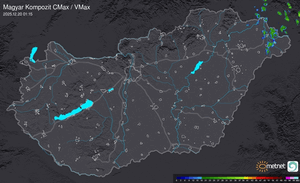Meteorológiai esélylatolgatások
Kérdés, hogyha ez lesz a finálé (FW), akkor a szükséges "várakozási idő" után - amíg leér a talajra a hatás- akár néhány hidegbetörés után elkezdődhetne-e egy, elmúlt éveknél korábbi tavasz a mostanában már lassan szokásossá váló hidegbetörésekkel tűzdelt, időnként májusi fűtéssel fémjelzett tavasz helyett?
Vajon van-e az FW időpontja és a tavasz (méginkább nyár) kezdet időpontja között összefüggés?
Próbálkoztam az AI-vel, lövése sincs (nincsenek adatai ).
).
Aztán ezt találtam (https://studenttheses.uu.nl/bitstream/handle/20.500.12932/38931/Thesis_Jonna_final.pdf?sequence=1):
In recent years, spring temperatures have been rising faster than yearly averaged temperatures. This spring amplification could be a result of the observed changed position of stationary waves near the surface of the earth. At the same time, it is observed that recently the seasons in the stratosphere, which is a layer of the atmosphere from approximately 10 to 50 km above the earth’s surface, are changing from winter to summer later in the year. This change of seasons is characterized by the stratospheric polar vortex, which is cyclonic in winter and anticyclonic in summer. Our hypothesis is that the spring
amplification has a connection to the delay of the stratospheric transition from winter to summer. Using re-analysis of the ERA-Interim data of ECMWF, we investigate the changes in the behaviour of the stratospheric polar vortex and look for relations between the spring amplification and the stratospheric polar vortex. Potential vorticity and planetary waves form the connection between the stratosphere and the troposphere and will be used to explain possible relations. It is found that the transition to summer in the stratosphere might be delayed, but the correlation is weak and thus it cannot be said with certainty. The time lag between the reversal in the higher and lower stratosphere shows more variation, the planetary wave activity plays a big role in the early onset dates for the final warming but not in the later onset dates, the northern annular mode index, indicating the pressure distribution, is not showing a trend in the months of March to May, and a significant relation between the date of the reversal of the stratospheric polar vortex and the mean index of the NAM over the period of March to May could not be found. Further research is needed to investigate the role of the strength of the polar vortex in relation to the NAM-index.
Vajon van-e az FW időpontja és a tavasz (méginkább nyár) kezdet időpontja között összefüggés?
Próbálkoztam az AI-vel, lövése sincs (nincsenek adatai
Aztán ezt találtam (https://studenttheses.uu.nl/bitstream/handle/20.500.12932/38931/Thesis_Jonna_final.pdf?sequence=1):
In recent years, spring temperatures have been rising faster than yearly averaged temperatures. This spring amplification could be a result of the observed changed position of stationary waves near the surface of the earth. At the same time, it is observed that recently the seasons in the stratosphere, which is a layer of the atmosphere from approximately 10 to 50 km above the earth’s surface, are changing from winter to summer later in the year. This change of seasons is characterized by the stratospheric polar vortex, which is cyclonic in winter and anticyclonic in summer. Our hypothesis is that the spring
amplification has a connection to the delay of the stratospheric transition from winter to summer. Using re-analysis of the ERA-Interim data of ECMWF, we investigate the changes in the behaviour of the stratospheric polar vortex and look for relations between the spring amplification and the stratospheric polar vortex. Potential vorticity and planetary waves form the connection between the stratosphere and the troposphere and will be used to explain possible relations. It is found that the transition to summer in the stratosphere might be delayed, but the correlation is weak and thus it cannot be said with certainty. The time lag between the reversal in the higher and lower stratosphere shows more variation, the planetary wave activity plays a big role in the early onset dates for the final warming but not in the later onset dates, the northern annular mode index, indicating the pressure distribution, is not showing a trend in the months of March to May, and a significant relation between the date of the reversal of the stratospheric polar vortex and the mean index of the NAM over the period of March to May could not be found. Further research is needed to investigate the role of the strength of the polar vortex in relation to the NAM-index.


